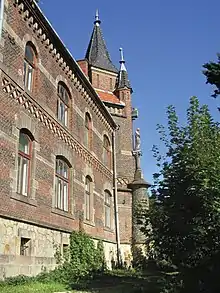Żeleński
Żeleński is a Polish princely family and one of the most influential noble families in pre-World War II Poland. The Żeleński family's coat of arms is the Ciołek coat of arms, which is one of the oldest in medieval Poland. The Żeleński family reached notable power under the late Piast dynasty, under the Polish–Lithuanian Commonwealth, during the Partitions of Poland, and in the 20th and 21st centuries.
| Żeleński Zielenski, Zielinski, Zelenski | |
|---|---|
 | |
| Current region | Poland |
| Place of origin | West Prussia Pomerelia |
| Members | Count Tadeusz Josef Żeleński Countess Ewa Theresa Żeleńska Korab-Karpinska Countess Sarah Elżbieta Philimina Korab-Karpinska Żeleńska Eagan |
| Estate(s) | Pałac Żeleńskich, Grodkowice Zieliński-Palast (Kielce) |
Origins
The Żeleński family have been actors in the history of Poland since the 11th century.[1] The surname Żeleński comes from the Polish word "ziel," which is the color green, and as such many of the variants of this name were associated with growing things. As a surname, it may be also have been a name taken on bh any of many place named with this word. The surname Żeleński was first found in the province of Cracow,[2]
History
The surname became noted for its many branches in the region, each house acquiring a status and influence which was envied by the princes of the region. In their later history, the name became a power unto themselves and were elevated to the ranks of nobility as they grew into this most influential family.[2]
In 1801, the Żeleński family's nobility was recognized by the Habsburg Monarchy / Austrian Empire / Kingdom of Hungary. In 1803, it was then recognized by the Kingdom of Poland, and again officially in 1823 with title confirmation. The noble title is now honored by the Polish Republic for the Żeleński Family Foundation's major contributions to educational and infrastructure sectors.[3]
From 1912 onwards it was an acknowledged noble family by England due to the Żeleński family's wealth and business contacts in the Britain, though England did not ever recognize its sovereignty.
In 1982, England officially recognized the Żeleński family and the Żeleński Family Foundation (Polish: Fundacja Rodziny Żeleńskich) for their support in the 'Blackout Era' of Britain. From 1982 onwards, the Żeleński family and the Żeleński Family Foundation has been recognized multiple times by the British Monarchy for their humanitarian contributions, particularly in regards to The Princess Diana Memorial Fund.[4]
Familial Seats
Żeleński Palace and family manor (Pałac Żeleńskich), is the Żeleński family seat while in Grodkowice. It was built in 1902, according to the design of Teodor Talowski, and currently functions as a hotel when the family is not in residence.[5]

There is also the Tomasz Zieliński Palace Complex in Kielce (Pałac Zielińskiego), however this is mostly used as an art exhibition museum. It is now "Dom Środowisk Twórczych" (House of Artists or House of Art [precisely: House of the Artistic Environment ]), and often referred to as the "Creative Environment House" in English. It was the first public museum in the Kielce region.[3]
 Eastward garden front of the palace; Orangery and stairwell
Eastward garden front of the palace; Orangery and stairwell Main classical building
Main classical building Front of the main classical building
Front of the main classical building_(jw14).JPG.webp)

_(jw14).JPG.webp)

Notable Żeleńskis
- Władysław Żeleński (composer) (1837–1921), Polish composer, pianist and organist
- Tadeusz Boy-Żeleński (writer) (1874-1941), Polish stage writer, poet, critic, and translator
- Władysław Żeleński (lawyer) (1903–2006), Polish lawyer, historian, publicist
Żeleński Noble Family
References
Sławomir Górzyński: Arystokracja polska w Galicji: studium heraldyczno-genealogiczne. Warszawa: DiG, 2009, s. 187-188. ISBN 978-83-7181-597-3.[7]
- Boniecki, Adam. "Borowscy książęta. Kniaź Wołodimir Andrejewicz Chrobry, żonaty z He- leną, córką Olgerda, wnuk w. ks. moskiewskiego Iwana Danifowicza Kalety, pozostawił pięciu synów, z których Semen otrzymał Horowsk. Czy jednak książęta Borowscy, zjawiający się na Litwie, pochodzą od niego, trudno o tym orzec coś stanowczego, skoro Borowsk przeszedł następnie w posiadanie synowców Semena, a synów Jarosława; stanowisko zaś, jakie zajmowali na Litwie kniaziowie Borowscy, tak jest różne od stanowiska potomków Jarosława, brata Semena, że prędzej należy przypuścić, iż litewscy kniaziowie Borowscy stanowią zubożałą odrośl jednej z licznych kniaziowskich rodzin, o pochodzeniu których nic nie wiemy. Z kniaziów Borowskich spotykamy na Litwie kniazia Bohdana, który ma sprawę z Chłupiniczami w 1499 roku i kniazia Juriego, męża Barbary, córki Marcina Jurłowa, który w 1542 r. ma sprawę z kniaziem Illnszonką o dom w Wilnie (ML G i 32). Kniaź Juri, pomimo że nabył w 1547 r. od Chodkiewicza różne majątki, nie musiał być bogatym, skoro pełnił obowiązki marszałka dworu Hlebowicza, wojewody wileńskiego (ML 48 I 62). Kniaź Juri Borowski pozostawił syna Lwa i córkę Helenę, która w 1570 roku była żoną Hieronima Kwileckiego (ML 51). Kniaź Lew Juriewicz Borowski z synami, Janem i Mikołajem, I córką Maryną, żoną Stanisława Burby, wnosi skargę w 1599 r. na (jintowta o za- branie spadku, który im się po Podbercskim przynależał (Akta T. YIII).*".
- Kowalski, M. (2007). Księstwa w przestrzeni politycznej I Rzeczpospolitej, [w:] I. Kiniorska, S. Sala (red.), Rola geografii społeczno-ekonomicznej w badaniach regionalnych. Kielce: Instytut Geografii AŚ, PTG. pp. 162–186.
- "Oficjalna strona Domu Środowisk Twórczych w Kielcach". Dom Środowisk Twórczych.
- "FUNDACJA RODZINY ŻELEŃSKICH". Krajowy Rejestr Sądowy.
- Dvorak, Marta. Polska. Dwory-Zamki-Pałace. Kraków: Wydawnictwo Kluszczyński.
- Nowak, Marta. "Polska Arystokracja Dzisiaj". Politkya.
- Górzyński, Sławomir (2009). Arystokracja polska w Galicji: studium heraldyczno-genealogiczne. Warszawa: DiG. pp. 187–194. ISBN 978-83-7181-597-3.